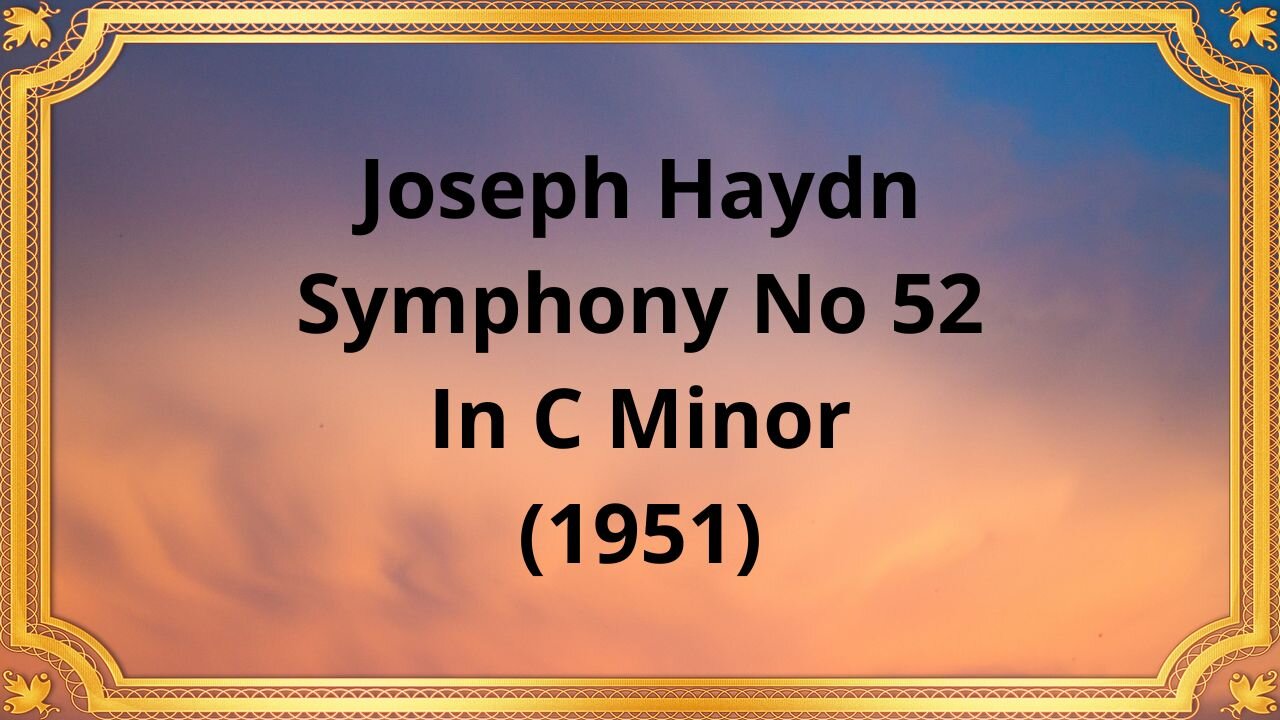Premium Only Content

Joseph Haydn Symphony No 52 In C Minor (1951)
#ClassicalMusic #JosephHaydn #SymphonyNo52 #CMajor #MusicalComposition #OrchestralMusic #ClassicalEra #HaydnSymphonies
#ClassicalComposers #MusicAppreciation
Publication date 1951
Orchester Der Wiener Staatsoper
Anton Heiller Conductor
Joseph Haydn's Symphony No. 52 in C Minor, also known as "The Grand Symphony," is a masterpiece of the classical era. Composed in 1771, it is one of Haydn's lesser-known symphonies but holds immense artistic significance.
Symphony No. 52 opens with a captivating and dramatic introduction in the minor key, setting the tone for the entire piece. As the music unfolds, Haydn skillfully alternates between moments of tension and resolution, creating a sense of musical narrative that keeps the listener engaged throughout.
The first movement, marked Allegro assai, showcases Haydn's mastery of orchestration and his ability to create dynamic contrasts. The symphony is predominantly characterized by its energetic and lively themes, with the orchestra engaging in a lively dialogue. The development section explores various thematic variations, showcasing Haydn's inventive compositional techniques.
The second movement, marked Andante, provides a stark contrast to the preceding movement. Here, Haydn demonstrates his unparalleled ability to evoke deep emotions through music. The slow tempo and lyrical melodies create a sense of introspection and introspection. The orchestration is delicate, with the strings taking center stage and weaving a melancholic tapestry of sound.
The third movement, marked Menuetto: Allegro, brings a sense of playfulness and charm to the symphony. Haydn's use of syncopation and rhythmic interplay adds a delightful touch to this movement, making it a joyful and spirited dance. The minuet is followed by a contrasting Trio section, which provides a moment of respite before returning to the lively minuet.
The finale, marked Presto, brings the symphony to a thrilling conclusion. Haydn's use of rapid-fire melodies, intricate counterpoint, and vibrant orchestration create a sense of exhilaration and intensity. The music builds up to a grand and triumphant finale, leaving the audience in awe of Haydn's compositional brilliance.
Haydn's Symphony No. 52 in C Minor is a testament to the composer's creativity and innovation. Through its dramatic intensity, emotional depth, and technical brilliance, this symphony showcases Haydn's mastery of the classical form. Despite being overshadowed by some of his more famous works, Symphony No. 52 stands as a testament to Haydn's genius and deserves recognition for its significant contributions to classical music.
In conclusion, Joseph Haydn's Symphony No. 52 in C Minor is a captivating musical composition that showcases the composer's mastery of orchestration, inventive compositional techniques, and ability to evoke a wide range of emotions. Its combination of dramatic intensity, lyrical beauty, and technical brilliance make it a true gem of the classical era.
You have the opportunity to support the channel:
https://destream.net/live/RadSiarAl/donate
-
 5:19:50
5:19:50
SLS - Street League Skateboarding
8 days ago2024 SLS Tokyo: Women’s and Men’s Knockout Rounds
476K12 -
 2:51:00
2:51:00
Fresh and Fit
6 hours agoWomen Claim To Give Better Dating Advice So We Did THIS...
103K60 -
![[F EM UP Friday] Take # 2 [Destiny 2] Lets Kick Some A$$! #RumbleTakeOver](https://1a-1791.com/video/s8/1/c/W/7/1/cW71u.0kob-small-F-EM-UP-Friday-Take-2-Desti.jpg) 5:16:50
5:16:50
CHiLi XDD
7 hours ago[F EM UP Friday] Take # 2 [Destiny 2] Lets Kick Some A$$! #RumbleTakeOver
33.1K1 -
 5:13:43
5:13:43
ItsMossy
13 hours agoHALO WITH THE RUMBLERS (: #RUMBLETAKEOVER
29.7K1 -
 1:54:08
1:54:08
INFILTRATION85
7 hours agoHi, I'm INFILTRATION
31.7K9 -
 7:51:03
7:51:03
GuardianRUBY
8 hours agoRumble Takeover! The Rumblings are strong
61.8K2 -
 4:28:45
4:28:45
Etheraeon
16 hours agoWorld of Warcraft: Classic | Fresh Level 1 Druid | 500 Follower Goal
45.5K -
 3:17:21
3:17:21
VapinGamers
8 hours ago $3.60 earned🎮🔥Scrollin’ and Trollin’: ESO Adventures Unleashed!
31.2K2 -
 LIVE
LIVE
a12cat34dog
9 hours agoGETTING AFTERMATH COMPLETED :: Call of Duty: Black Ops 6 :: ZOMBIES CAMO GRIND w/Bubba {18+}
318 watching -
 8:23:18
8:23:18
NubesALot
11 hours ago $5.12 earnedDark Souls Remastered and party games
27.9K